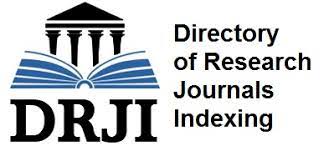Submissions
Submission Preparation Checklist
As part of the submission process, authors are required to check off their submission's compliance with all of the following items, and submissions may be returned to authors that do not adhere to these guidelines.- The submission has not been previously published, nor has it been submitted for consideration to any other journal (or an explanation has been provided in the Editor's Comments).
- The text adheres to the stylistic, formatting and bibliographic requirements given in the style guidelines below, and the file extension is in Microsoft Word
- URLs or DOIs are provided for references, when possible
- If submitted to a peer-reviewed section of the journal, the instructions for ensuring anonymous review below are followed
- In addition to the document with the text body, another document with personal data is sent
Papers
In the papers the author(s) show the original result of the research. They have a length between 6,000 and 8,000 words and are evaluated by double-blind peer review.
Notes and Comments
Texts reporting on books, congresses, symposiums and other activities related to the topics of the journal. They will have a maximum length of 4,000 words. They are not peer-reviewed.
Book reviews
They are up to 1800 words in length. Only in exceptional cases, reviews of books more than five years old will be accepted. The works reviewed must be first editions, or reprints with substantial modifications. To avoid conflicts of interest, it is preferable that they are not written by people close to the author of the reviewed book or who have collaborated in its edition or design. Neither should the author of a reviewed book have professional ascendancy over the author of the review, as is the case of a thesis director. Not peer revewed.
Essays
Following a restructuring of the journal (01/2024) such submissions are no longer accepted.
Debates
Following a restructuring of the journal (01/2024) such submissions are no longer accepted.
Philosophical creation
Following a restructuring of the journal (01/2024) such submissions are no longer accepted.
News and Comments
Following a restructuring of the journal (01/2024) such submissions are no longer accepted.
Copyright Notice
Those authors who have publications with this journal, accept the following terms:
1. All content published in Naturaleza y Libertad is open acces without limit, and are subject to the Attribution-NonCommercial-ShareAlike 4.0 International (CC BY-NC-SA 4.0) license. The full text of which can be consulted at https://creativecommons.org/licenses/by-nc-sa/4.0/
2. It is the responsibility of the authors to obtain the necessary permissions for the images that are subject to copyright. The authors whose contributions are accepted for publication in this journal will retain the non-exclusive right to use their contributions for academic, research and educational purposes, including self-archiving or deposit in open access repositories of any kind. The electronic edition of this magazine is edited by the Editorial de la University of Malaga (UmaEditorial), being necessary to cite the origin in any partial or total reproduction.
3. This journal allows and encourages authors to publish papers on their personal websites or in institutional repositories, both before and after their publication in this journal, as long as they provide bibliographic information that accredits, if applicable, your posting on it.
4. In no case will anonymous papers be published.
Privacy Statement
In compliance with Regulation (EU) 2016/679 of the European Parliament and of the Council, regarding the protection of individuals with regard to the processing of personal data and the free circulation of these data (RGPD), we inform you that the personal data you provide us through the portal https://revistas.uma.es/, via telephone, or by email will be treated confidentially and will become part of a file owned by the University of Malaga that has been duly registered with the Spanish Agency for Data Protection (www.agpd.es). Your personal data will be used to meet your request for information, the management and provision of the services offered by UMA Editorial, and to send future commercial communications that may be of interest to you.
Likewise, we inform you that you can exercise your rights of access, rectification, cancellation and opposition in accordance with the provisions of Regulation (EU) 2016/679 of the European Parliament and of the Council, regarding the protection of natural persons with regard to the processing of personal data and the free circulation of these data (RGPD), by sending a letter together with a photocopy of your ID, to the following address: Bulevar Louis Pasteur, 30 (Campus de Teatinos ), Apdo. 3149, 29071, Malaga.
The data requested from the User through forms indicated with an asterisk (*) will be those strictly necessary to be able to provide the service or to be able to contact the User. In no case, the fact of not providing more data than what is strictly necessary will imply a reduction in the quality of the service.
The User guarantees that the personal data provided is true and is responsible for communicating any changes in them. The User will be solely responsible for any damage or harm, direct or indirect, that could be caused to UMA Editorial or to any third party, due to filling in the forms with false, inaccurate, incomplete or out-of-date data. In the event that the User includes personal data of third parties, he must, prior to its inclusion, inform them of the provisions of this privacy policy, being solely responsible for its inclusion.
18.png)













